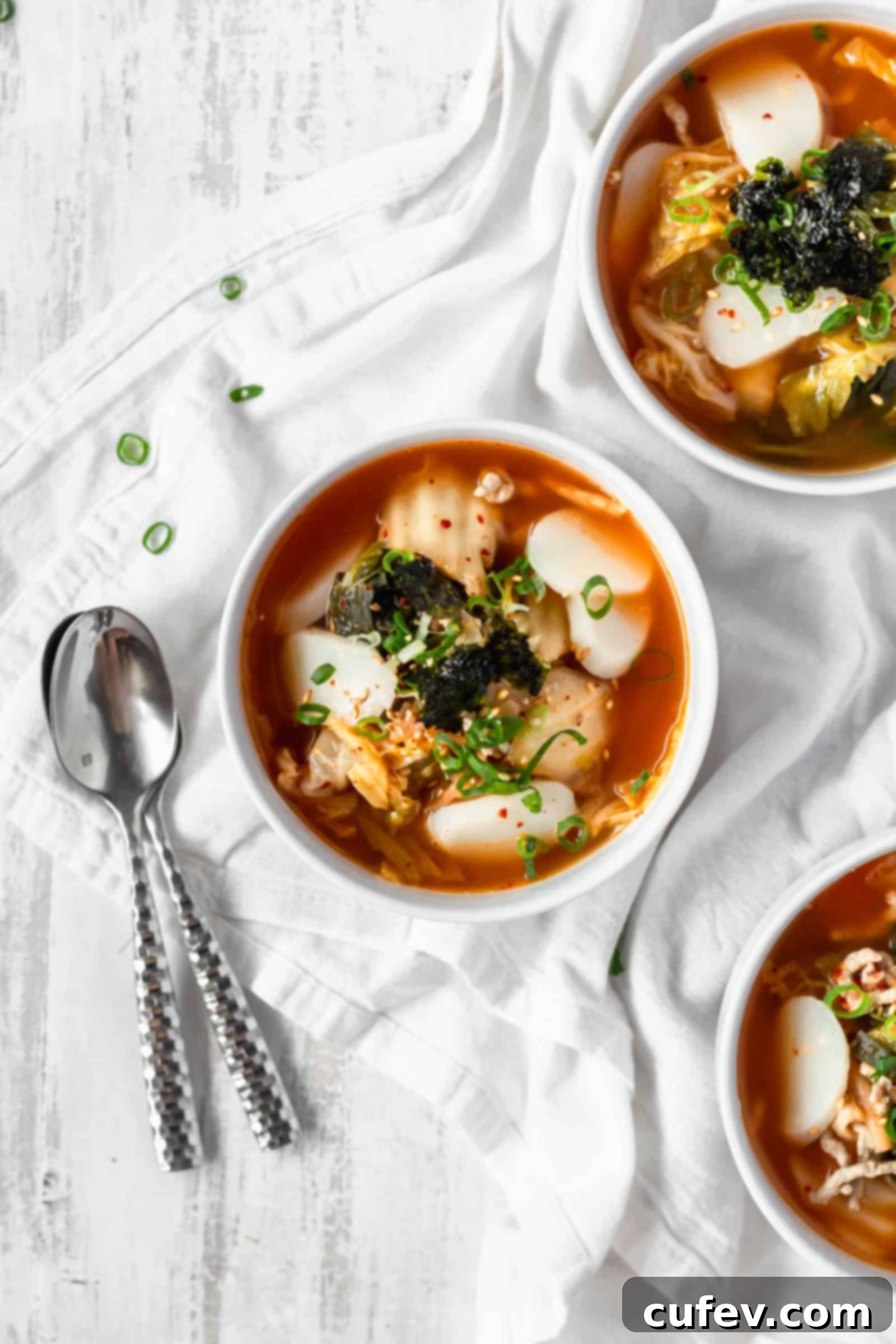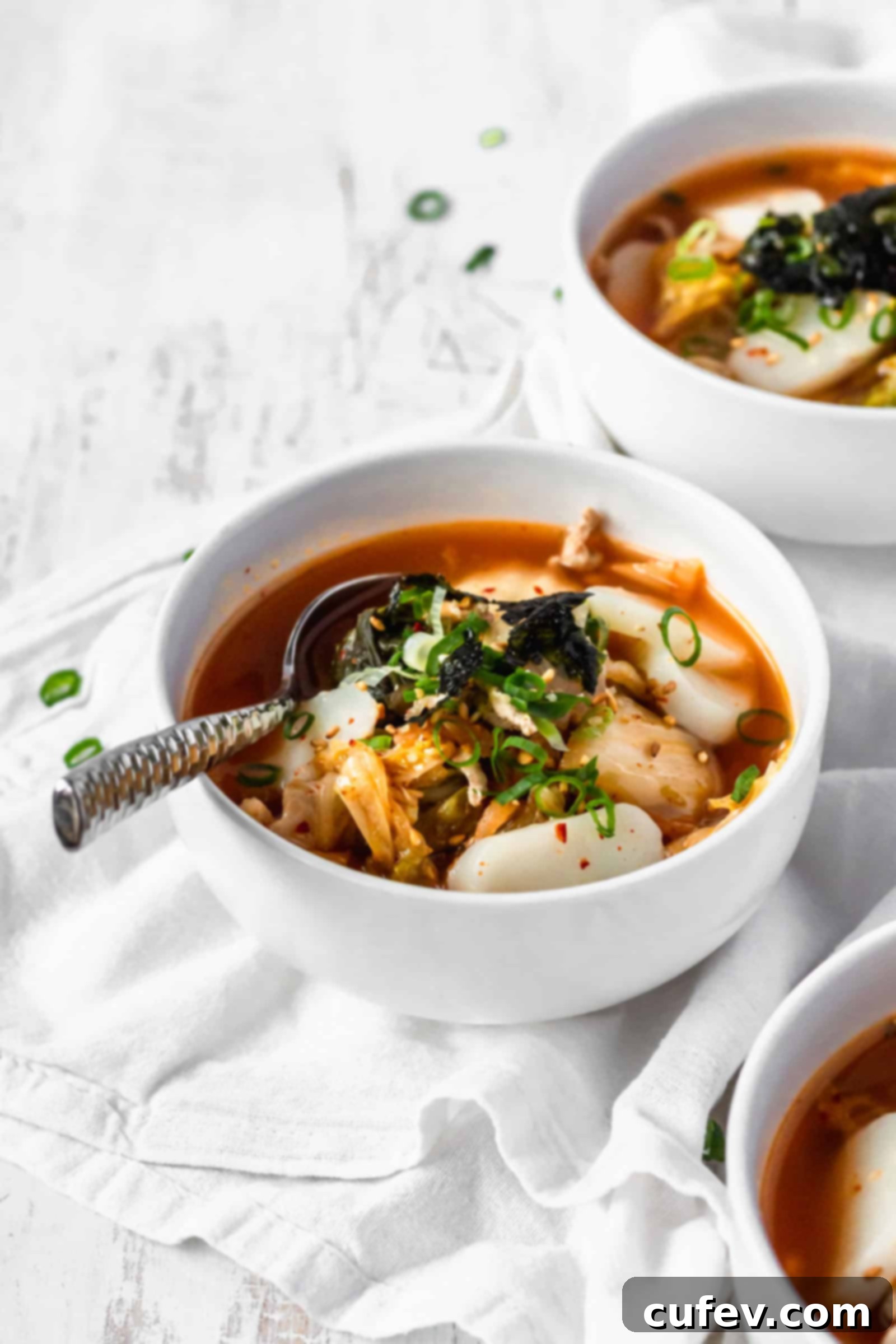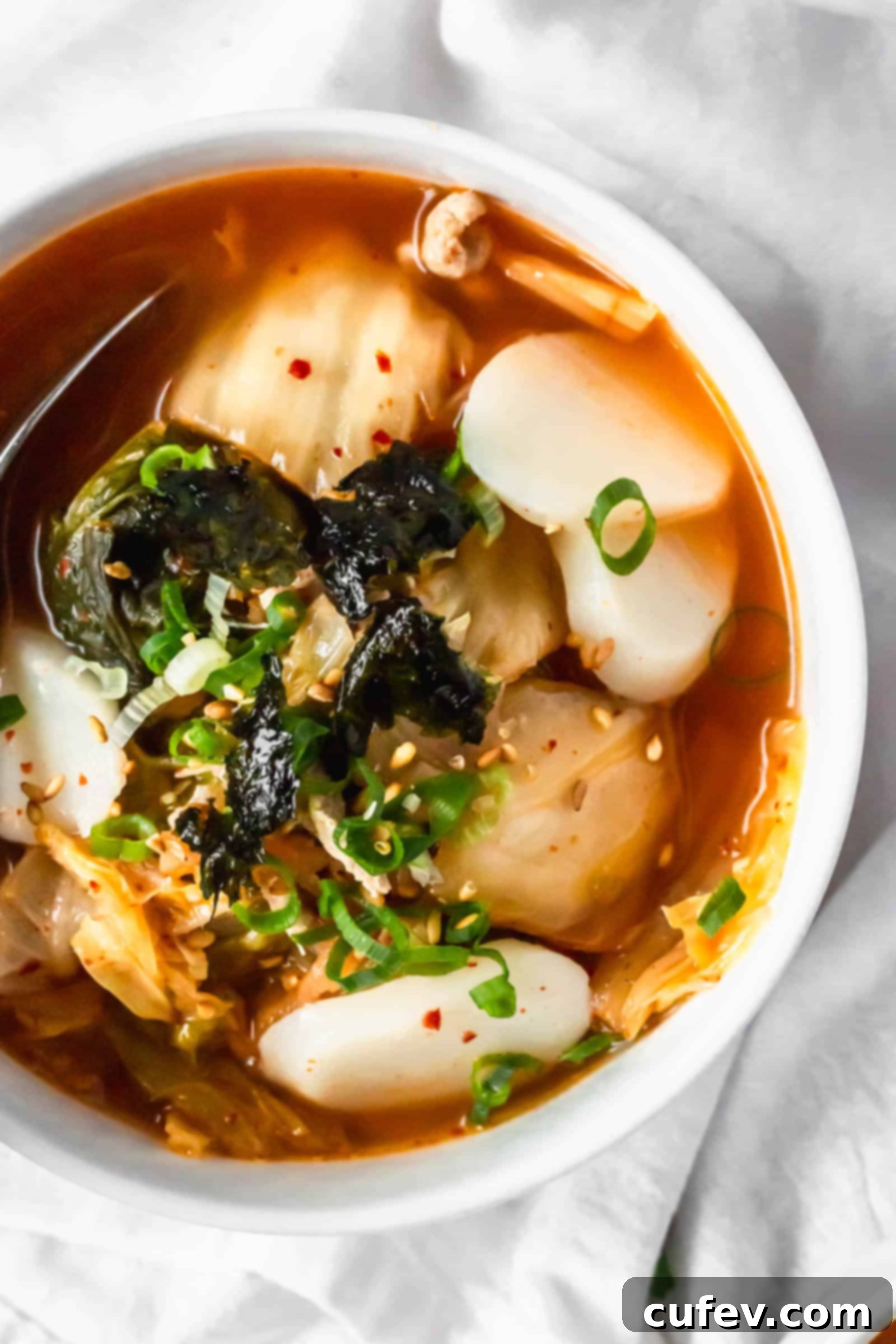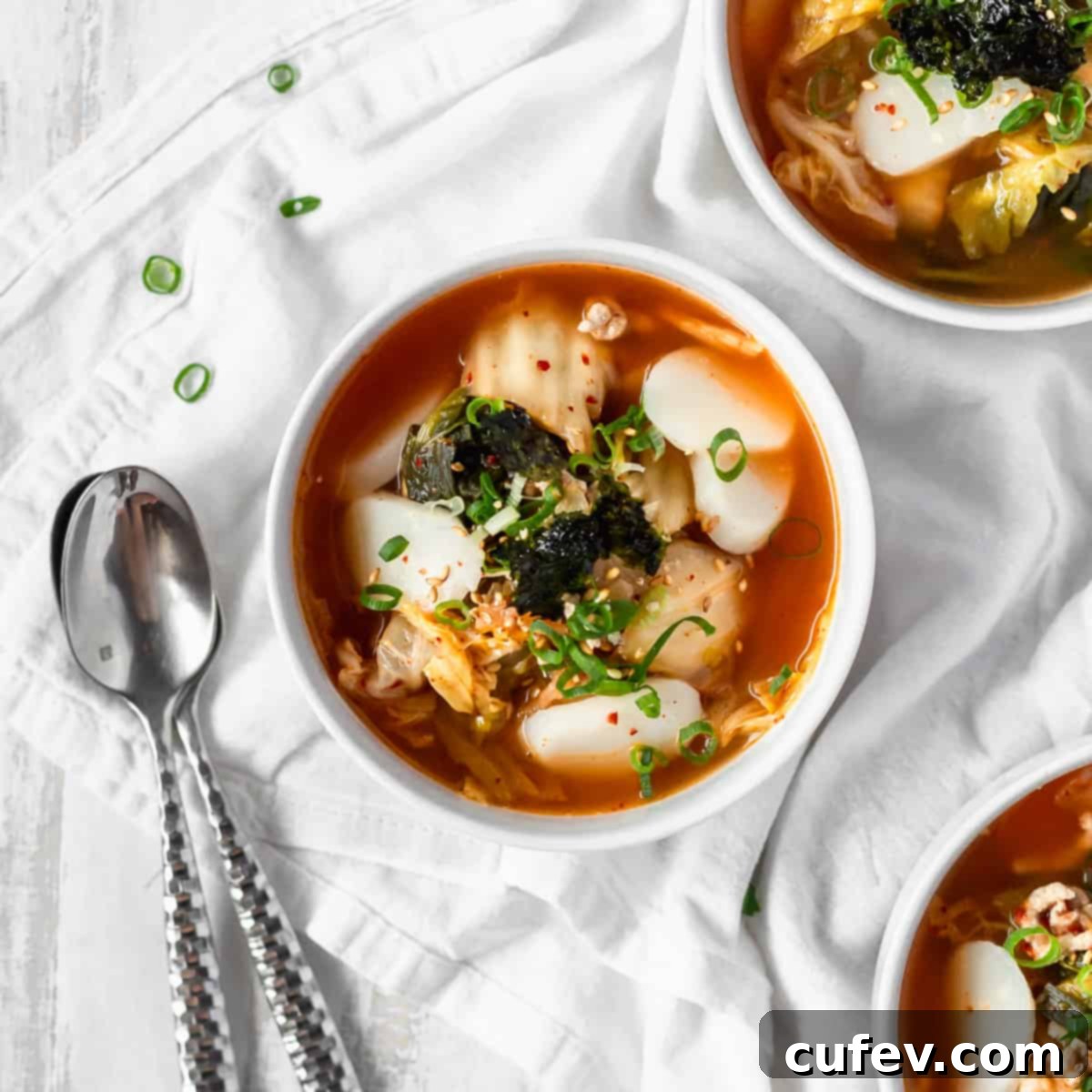Easy & Authentic Tteokguk Recipe: The Ultimate Korean Rice Cake Soup for Comfort and Celebration
There are few dishes as comforting and culturally significant in Korean cuisine as a warm, hearty bowl of Tteokguk (Korean Rice Cake Soup). This traditional Korean soup, brimming with deliciously chewy rice cakes, savory broth, and often tender meat, is not just a meal; it’s an experience, especially during the Lunar New Year (Seollal). Whether you’re seeking a soul-warming dish on a cold day or looking to embrace a culinary tradition, this easy-to-follow tteokguk recipe promises to nourish your body and delight your taste buds. We’ll guide you through crafting a truly authentic and incredibly satisfying bowl, making this beloved Korean classic accessible for every home cook.

This comprehensive guide and recipe were originally published on January 15, 2019, and meticulously updated with new insights, detailed steps, and expanded information on November 19, 2023, to provide the most current and helpful content.
What is Tteokguk (Korean Rice Cake Soup)?
Tteokguk (떡국), pronounced “teok-guk,” is a cherished Korean soup primarily featuring thin, oval-shaped rice cakes (tteok) served in a savory broth. More than just a simple soup, it holds deep cultural significance, particularly as a staple dish consumed during the Lunar New Year (Seollal) festivities. Eating tteokguk on New Year’s Day is believed to symbolize longevity and good fortune for the coming year. The white color of the rice cakes represents purity and a fresh start, while their oval shape is said to resemble ancient Korean coins, signifying prosperity and wealth.
While traditionally made with a clear beef broth and often garnished with shredded egg omelet (jidan), various regional and family variations exist. Some versions use anchovy or seafood broth, while others incorporate chicken or pork. The beauty of tteokguk lies in its versatility and the comforting chewiness of the rice cakes that absorb the rich flavors of the broth. It’s a dish that embodies warmth, tradition, and the hopeful spirit of new beginnings.
For an extra layer of flavor and a delightful kick, I absolutely love adding kimchi to my tteokguk. The fermented cabbage introduces a complex tang and a satisfying heat that elevates the soup to another level. While entirely optional, I wholeheartedly recommend trying this variation if you appreciate spicy and tangy flavors in your soup. It transforms a classic comfort food into an exciting and probiotic-rich meal.

Key Ingredients for the Perfect Tteokguk
Crafting a delicious tteokguk relies on a few core ingredients, each playing a crucial role in the soup’s overall flavor and texture. Here’s a detailed look at what you’ll need and some helpful tips for each:
- Broth (Stock). The foundation of any great soup is its broth. Traditionally, tteokguk features a deeply flavored homemade beef broth, often simmered for hours to extract maximum flavor. However, for a more convenient yet equally delicious version, you have several excellent options. You can use a high-quality store-bought beef broth, or explore other clear broths like dashi (Japanese kelp and bonito flake stock) or anchovy broth (a common base in Korean cooking). These alternatives offer distinct umami profiles and allow for flexibility based on your preference or dietary needs. For a quick homemade option, simmering a few pieces of dried anchovies and kombu (dried kelp) in water for 15-20 minutes creates a flavorful and light stock.
- Beef (or other protein). While traditional tteokguk recipes often call for thinly sliced beef brisket for its rich flavor and tender texture after simmering, our easy version utilizes ground beef. Ground beef cooks quickly and integrates seamlessly into the soup, making it perfect for a weeknight meal. You can also experiment with other proteins like thinly sliced pork, chicken, or even a vegetarian option like mushrooms or firm tofu, ensuring the dish remains satisfying and adaptable.
- Aromatics: Garlic, Ginger, and Green Onions. These three ingredients are indispensable in Korean cooking, providing a vibrant and aromatic base for the soup. Minced garlic and ginger infuse the broth with warmth and depth, while fresh green onions add a mild oniony bite and a beautiful green garnish. Don’t skimp on these; they are essential for that authentic Korean flavor.
- Tteok (Korean Rice Cakes). These are the star of the show! You’ll need specifically sliced oval rice cakes (often labeled “tteokguk tteok”). They have a wonderfully chewy texture that is unique to Korean rice cakes. If you can only find long cylindrical rice cakes, known as garaetteok, you can easily slice them yourself into thin, coin-like pieces. Before cooking, it’s often recommended to soak dried rice cakes in cold water for about 15-30 minutes to soften them slightly and prevent them from breaking apart or becoming too hard during cooking. Fresh rice cakes may not require soaking, but a quick rinse is always a good idea.
- Soy Sauce. This essential condiment adds a crucial layer of umami and saltiness to the broth. Depending on your preference, you can use regular soy sauce or a lighter, soup-specific soy sauce (guk-ganjang) which seasons the broth without significantly darkening its color. Adjust to taste, as different broths and ingredients will vary in their inherent saltiness.
- Toasted Sesame Oil. A drizzle of toasted sesame oil at the end of cooking is a game-changer. Even a small amount—just a teaspoon or so—imparts a nutty, aromatic richness that truly elevates the overall flavor profile of the tteokguk. It’s a finishing touch that signals authentic Korean cuisine and adds a delightful fragrance. Ensure it’s *toasted* sesame oil for that deep, complex aroma.
- Salt and Pepper. Simple yet crucial for fine-tuning the seasoning. Always taste your soup before serving and adjust with salt and freshly ground black pepper to achieve your desired balance of flavors.
- Kimchi (Optional, but highly recommended). For those who love a bit of spice and tang, adding kimchi is a fantastic enhancement. The fermented cabbage not only brings a zesty, spicy flavor but also introduces beneficial probiotics, making your tteokguk even healthier. The acidity of the kimchi also cuts through the richness of the broth, creating a more dynamic and exciting flavor profile. Use well-fermented kimchi for the best results.
- Seaweed Sheets (Garnish). Known as gim in Korean or nori in Japanese, thinly shredded roasted seaweed is a popular and aesthetically pleasing garnish. It adds a subtle oceanic flavor and a delicate crispness that contrasts beautifully with the soft rice cakes. You can buy pre-shredded seaweed or cut full sheets into thin strips.
- Sesame Seeds (Garnish). Toasted sesame seeds provide a final touch of nutty flavor and a lovely visual appeal. Sprinkle them generously over your finished bowls for an added layer of aroma and texture.
- Egg Garnish (Jidan – Optional). A traditional garnish for tteokguk is jidan, which is a thin, decorative egg omelet typically separated into white and yellow strands. To make jidan, lightly beat egg whites and yolks separately, then fry them into thin crepes. Stack and slice them into fine strips. This adds color and a delicate protein element to the soup. If time is short, a simple fried or poached egg can also be a wonderful addition.

Step-by-Step: How to Make Easy Korean Rice Cake Soup (Tteokguk)
Making tteokguk at home is surprisingly simple and quick, especially with our streamlined approach. Follow these steps to create a delicious and authentic Korean rice cake soup:
Preparation:
- If using dried rice cakes (tteok), ensure you soak them in cold water for 15-30 minutes beforehand. This helps them soften and cook evenly without becoming too mushy or breaking apart. Drain them well before adding to the soup.
- Prepare your aromatics: mince the garlic and ginger, and chop your green onions.
- If making jidan (egg garnish), prepare it now. Whisk egg whites and yolks separately, fry thin crepes, and slice into fine strips.
Cooking the Soup:
Step 1: Infuse the Broth. In a large pot, combine your chosen stock or broth (beef, anchovy, or dashi), minced garlic, and minced ginger. Cover the pot with a lid and bring the mixture to a rolling boil over medium-high heat. Allow it to simmer for a few minutes to let the flavors meld beautifully.
Step 2: Cook the Ground Beef and Green Onions. Once the broth is boiling, add the ground beef to the pot. Using a wooden spoon or spatula, break up the ground beef into small pieces as it cooks. Stir in the chopped green onions. Continue to cook for approximately 5 minutes, or until the beef is fully browned and cooked through. This step ensures the beef adds its savory depth to the broth.
Step 3: Add the Rice Cakes. Carefully add the soaked and drained tteok (rice cakes) to the simmering soup. Stir gently to ensure they are fully submerged. Cook the rice cakes according to the package directions, which typically takes about 5 to 8 minutes. You’ll know they’re ready when they become tender and float to the top of the soup. Be careful not to overcook them, as they can become overly soft and mushy.
Step 4: Season and Garnish. Turn off the heat. Stir in the soy sauce and a teaspoon of toasted sesame oil. Taste the soup and adjust the seasoning with salt and pepper as needed. This is also the point to add your optional kimchi, if desired. Ladle the hot tteokguk into individual serving bowls. Garnish each bowl generously with shredded seaweed (gim or nori), toasted sesame seeds, and your prepared egg jidan (if using). Serve immediately and enjoy your delicious homemade Korean rice cake soup!

Creative Variations and Essential Tips for Tteokguk Success
Tteokguk is wonderfully adaptable, allowing for numerous variations to suit different tastes and dietary preferences. Here are some ideas and crucial tips to ensure your soup is always perfect:
- Explore Different Broth Bases. Don’t limit yourself to just beef broth! As mentioned, dashi (Japanese stock made from kombu and katsuobushi) offers a lighter, oceanic umami, while anchovy broth is a quintessential Korean soup base that provides a clean, deep flavor. For a vegetarian or vegan version, use a high-quality vegetable stock or dashi made solely from kombu and dried shiitake mushrooms, completely omitting the ground beef and any other animal products.
- Protein Alternatives. While ground beef is convenient, feel free to substitute it with other proteins. Thinly sliced pork or chicken breast (or even shredded rotisserie chicken for extra ease) can be excellent choices. For a heartier, more traditional touch, you can slow-cook beef brisket in the broth until fall-apart tender. Vegetarians can opt for pan-fried firm tofu cubes or a generous amount of sautéed mushrooms (like shiitake or oyster mushrooms) for a satisfying texture and umami boost.
- Mandu-Tteokguk: Add Korean Dumplings! A popular variation, especially during Seollal, is to combine tteokguk with Korean dumplings (mandu). This dish is known as Mandu-tteokguk. You can use either fresh or frozen mandu. Simply add them to the simmering soup about 5-7 minutes before the rice cakes are fully cooked, or according to package instructions, ensuring they are heated through. This makes the soup even more substantial and flavorful.
- Egg Preparations. Beyond the traditional jidan, there are simpler ways to incorporate egg. You can scramble an egg directly into the hot soup just before serving, creating wispy egg ribbons. Alternatively, a perfectly poached egg or a fried egg with a runny yolk can be placed on top of each bowl for a rich and comforting addition.
- Adjust Spice Levels. If you enjoy heat, feel free to add a pinch of Korean chili flakes (gochugaru) along with the kimchi. You can also drizzle some chili oil over the top when serving for an extra kick. If you prefer a milder soup, simply omit the kimchi and chili flakes.
- Serving Suggestions. Tteokguk is often served as a complete meal, but it pairs wonderfully with various Korean side dishes (banchan) like extra kimchi, pickled radishes, or stir-fried vegetables. A bowl of freshly steamed rice can also be served alongside, though the rice cakes are quite filling on their own.
- Serve Immediately for Best Texture. The chewy texture of the tteok (rice cakes) is one of the most delightful aspects of tteokguk. To preserve this, it’s crucial to serve the soup as soon as it’s ready. The longer the rice cakes sit in the hot broth, the more they absorb liquid and can become overly soft or mushy, losing their characteristic chewiness.
- Clever Leftover Strategy. If you anticipate having leftovers, here’s a pro tip: only cook half the amount of tteok that you plan to eat in the first sitting. Enjoy that portion fresh. For the remaining broth and cooked ingredients, store them separately from uncooked tteok. The next day, when reheating the soup on the stove, add the fresh, uncooked tteok to the simmering broth and cook until tender. This ensures that the rice cakes in your leftover portion will also have that perfect, desirable chewy texture.

The Healthy Side of Tteokguk
Beyond its incredible flavor and comforting qualities, tteokguk, especially when made with kimchi, offers several health benefits. The inclusion of kimchi provides a significant boost of probiotics, which are essential for a healthy gut microbiome. A balanced gut can contribute to improved digestion, enhanced immune function, and even better mood. The soup also provides a good source of protein from the beef (or your chosen alternative), complex carbohydrates from the rice cakes for sustained energy, and essential vitamins and minerals from the green onions, garlic, and ginger. It’s a wholesome meal that truly nurtures the body from the inside out.
Why You’ll Love This Easy Tteokguk Recipe
This tteokguk recipe stands out for several reasons, making it a must-try for anyone interested in Korean cuisine or simply looking for a new comforting meal:
- Simplicity and Speed: Despite its rich flavors, this version is incredibly straightforward to make, perfect for busy weeknights. Most of the cooking time is hands-off, letting the broth simmer.
- Unbeatable Comfort: A warm bowl of tteokguk is the epitome of comfort food. The chewy rice cakes and savory broth provide a deeply satisfying experience.
- Customizable to Your Taste: From different broths and proteins to varying spice levels and garnishes, this recipe is highly adaptable. Make it vegan, add dumplings, or load it with kimchi – the possibilities are endless.
- Nutritious and Wholesome: Packed with protein, complex carbs, and beneficial ingredients like kimchi, it’s a balanced meal that’s good for you.
- Cultural Connection: Experience a taste of Korean tradition and celebrate special moments with this iconic New Year’s soup.
More Comforting Soups & Delicious Appetizers
If you enjoyed this recipe and are looking for more delightful dishes to warm your soul or kick off a meal, explore some of our other favorites:
- If you’re in the mood for a rich, creamy soup rather than a clear, brothy one, be sure to try our indulgent creamy vegan pumpkin soup recipe for a plant-based delight or this classic and cheesy broccoli cheddar soup.
- For a burst of garden-fresh flavor, our roasted tomato soup recipe is full of vibrant taste and makes the perfect companion to a gooey grilled cheese sandwich!
- If your love for dumplings extends beyond tteokguk, you’ll definitely want to try this savory vegetable gyoza recipe (add a placeholder link, as it was missing).
- And for those who simply adore dips, our luscious vegan spinach and artichoke dip is incredibly creamy and serves as an excellent accompaniment to fresh vegetable sticks, crispy chips, or crusty pieces of bread.

Tteokguk (Korean Rice Cake Soup)
Soup
Korean
15 minutes
15 minutes
4 big bowls
241kcal
Ai Willis
Print
Pin
Rate
Ingredients
- 7 cups stock or broth beef, anchovy, dashi, or vegetable stock
- 3 cloves garlic, minced
- 1-inch piece ginger, minced
- ½ pound ground beef or other protein like sliced pork, chicken, or mushrooms for vegetarian
- 1 cup chopped green onions plus extra for garnish
- 1 pound tteok (Korean sliced rice cakes) soaked in cold water for 15-30 minutes if dried
- 1 tablespoon soy sauce adjust to taste
- 1 teaspoon toasted sesame oil
- salt and freshly ground black pepper, to taste
- 1 to 2 cups kimchi optional, but highly recommended for a spicy kick
- shredded nori seaweed or Korean gim, to garnish
- toasted sesame seeds to garnish
- jidan (egg garnish) optional, for traditional presentation
Instructions
Preparation:
-
If using dried tteok (rice cakes), place them in a bowl and cover with cold water. Let them soak for 15-30 minutes until softened. Drain thoroughly before use. Fresh rice cakes may only require a quick rinse.
-
Mince garlic and ginger. Chop green onions, reserving some for garnish. If making jidan, prepare it now by separately whisking egg whites and yolks, frying thin crepes, and slicing into fine strips.
Cooking the Soup:
-
In a large pot, combine the 7 cups of stock/broth, minced garlic, and minced ginger. Cover the pot with a lid and heat over medium-high heat until it comes to a full boil. Allow it to simmer for 2-3 minutes to deepen the flavors.
-
Add the ½ pound of ground beef and 1 cup of chopped green onions (if not reserving all for garnish) to the boiling broth. Cook for about 5 minutes, breaking up the beef into fine pieces with a wooden spoon or spatula, until the beef is fully cooked and no longer pink.
-
Add the 1 pound of soaked and drained rice cakes to the pot. Stir gently. Cook for approximately 5-8 minutes, or according to the packaging instructions, until the tteok are tender and float to the top. Do not overcook to maintain their chewy texture.
-
Turn off the heat. Stir in 1 tablespoon of soy sauce and 1 teaspoon of toasted sesame oil. Taste for seasoning and add salt and pepper to your preference. If adding kimchi, stir in 1-2 cups now.
-
Ladle the hot tteokguk into individual bowls. Garnish generously with shredded nori seaweed, toasted sesame seeds, any reserved chopped green onions, and the prepared jidan (egg garnish) if using. Serve immediately to enjoy the best texture of the rice cakes.
Notes
- Serve immediately. The rice cakes can get mushy the longer they are left in the hot soup, so for the best chewy texture, serve this comforting soup as soon as it’s ready.
- Enjoy leftovers! If you plan to have leftovers for the next day, a smart tip is to not add all of the tteok (rice cakes) into the main pot during the initial cooking. Cook only the portion you intend to eat in one sitting. Store the remaining broth and cooked ingredients separately. The next day, when reheating the soup on the stove, simply add the uncooked tteok to the simmering broth and cook until tender. This method ensures your leftover rice cakes maintain their delightful chewiness.
- Adjust seasoning. Broth saltiness varies, so always taste and adjust soy sauce, salt, and pepper to your liking before serving.
- Vegetarian/Vegan Option: Replace beef with pan-fried firm tofu or mushrooms, and use vegetable or kombu-based dashi broth.
Love this recipe?Snap a photo and share tagging @aimadeitforyou or tag #aimadeitforyou!
